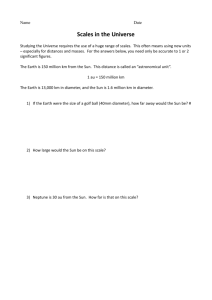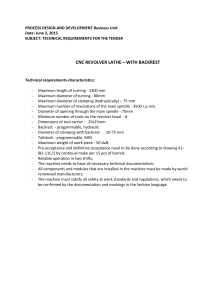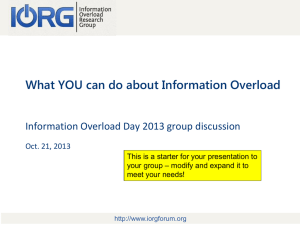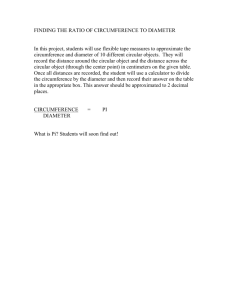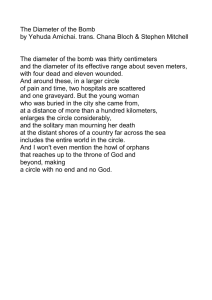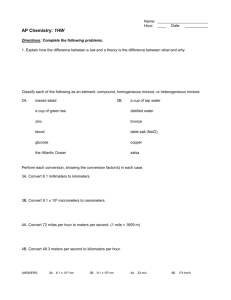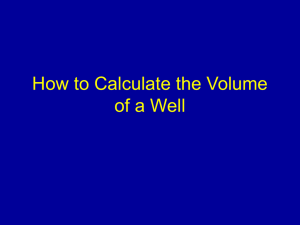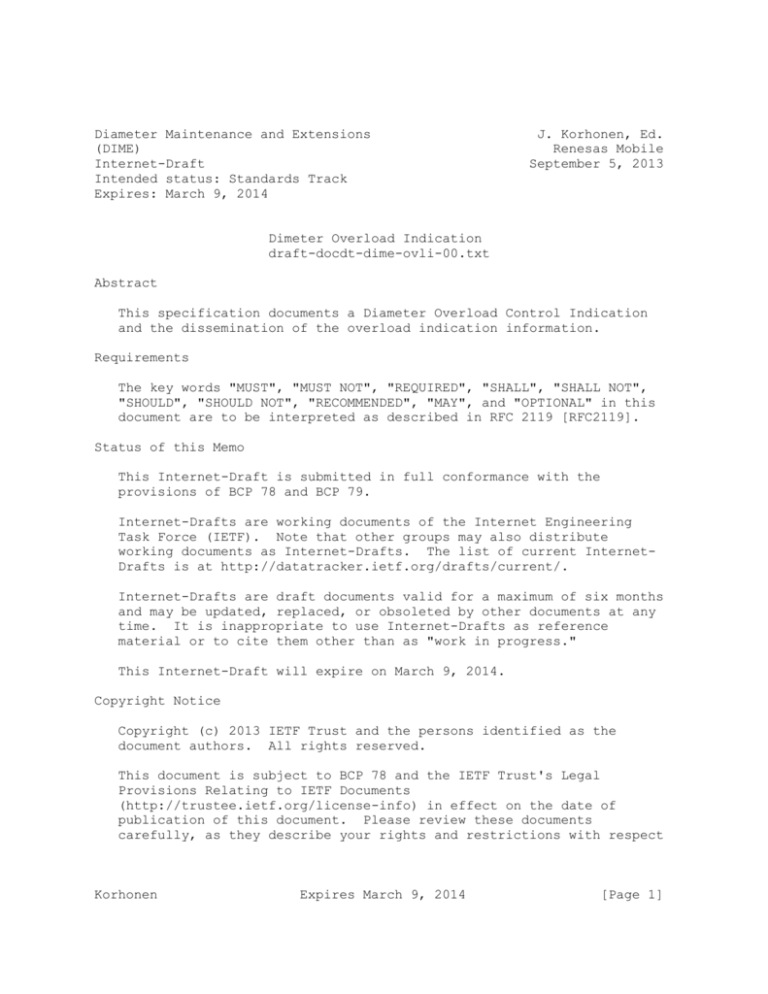
Diameter Maintenance and Extensions
(DIME)
Internet-Draft
Intended status: Standards Track
Expires: March 9, 2014
J. Korhonen, Ed.
Renesas Mobile
September 5, 2013
Dimeter Overload Indication
draft-docdt-dime-ovli-00.txt
Abstract
This specification documents a Diameter Overload Control Indication
and the dissemination of the overload indication information.
Requirements
The key words "MUST", "MUST NOT", "REQUIRED", "SHALL", "SHALL NOT",
"SHOULD", "SHOULD NOT", "RECOMMENDED", "MAY", and "OPTIONAL" in this
document are to be interpreted as described in RFC 2119 [RFC2119].
Status of this Memo
This Internet-Draft is submitted in full conformance with the
provisions of BCP 78 and BCP 79.
Internet-Drafts are working documents of the Internet Engineering
Task Force (IETF). Note that other groups may also distribute
working documents as Internet-Drafts. The list of current InternetDrafts is at http://datatracker.ietf.org/drafts/current/.
Internet-Drafts are draft documents valid for a maximum of six months
and may be updated, replaced, or obsoleted by other documents at any
time. It is inappropriate to use Internet-Drafts as reference
material or to cite them other than as "work in progress."
This Internet-Draft will expire on March 9, 2014.
Copyright Notice
Copyright (c) 2013 IETF Trust and the persons identified as the
document authors. All rights reserved.
This document is subject to BCP 78 and the IETF Trust's Legal
Provisions Relating to IETF Documents
(http://trustee.ietf.org/license-info) in effect on the date of
publication of this document. Please review these documents
carefully, as they describe your rights and restrictions with respect
Korhonen
Expires March 9, 2014
[Page 1]
Internet-Draft
Dimeter Overload Indication
September 2013
to this document. Code Components extracted from this document must
include Simplified BSD License text as described in Section 4.e of
the Trust Legal Provisions and are provided without warranty as
described in the Simplified BSD License.
Table of Contents
1. Introduction . . . . . . . . . . . . . . . . . . .
2. Terminology and Abbreviations . . . . . . . . . .
3. Solution Overview . . . . . . . . . . . . . . . .
3.1. Architectural Assumptions . . . . . . . . . .
3.1.1. Application Classification . . . . . . . .
3.1.2. Application Type Overload Implications . .
3.1.3. Request Transaction Classification . . . .
3.1.4. Request Type Overload Implications . . . .
3.1.5. Diameter Deployment Scenarios . . . . . .
3.1.6. Diameter Agent Behaviour . . . . . . . . .
3.1.7. Simplified Example Architecture . . . . .
3.2. Clarifications to Diameter Base Protocol . . .
3.3. Dissemination of the Overload Indication . . .
3.3.1. Negotiation and Versioning . . . . . . . .
3.3.2. Transmission of the Attribute Value Pairs
3.4. Overload Condition Indication . . . . . . . .
4. Attribute Value Pairs . . . . . . . . . . . . . .
4.1. xyz AVP . . . . . . . . . . . . . . . . . . .
4.2. abc AVP . . . . . . . . . . . . . . . . . . .
4.3. Attribute Value Pair flag rules . . . . . . .
5. Transport Considerations . . . . . . . . . . . . .
6. IANA Considerations . . . . . . . . . . . . . . .
6.1. AVP codes . . . . . . . . . . . . . . . . . .
6.2. Result-Code values . . . . . . . . . . . . . .
6.3. New registries . . . . . . . . . . . . . . . .
7. Security Considerations . . . . . . . . . . . . .
8. Design Team Members . . . . . . . . . . . . . . .
9. Acknowledgements . . . . . . . . . . . . . . . . .
10. References . . . . . . . . . . . . . . . . . . . .
10.1. Normative References . . . . . . . . . . . . .
10.2. Informative References . . . . . . . . . . . .
Appendix A. Examples . . . . . . . . . . . . . . . .
A.1. 3GPP S6a interface overload indication . . . .
A.2. 3GPP PCC interfaces overload indication . . .
Author's Address . . . . . . . . . . . . . . . . . . .
.
.
.
.
.
.
.
.
.
.
.
.
.
.
.
.
.
.
.
.
.
.
.
.
.
.
.
.
.
.
.
.
.
.
.
.
.
.
.
.
.
.
.
.
.
.
.
.
.
.
.
.
.
.
.
.
.
.
.
.
.
.
.
.
.
.
.
.
.
.
.
.
.
.
.
.
.
.
.
.
.
.
.
.
.
.
.
.
.
.
.
.
.
.
.
.
.
.
.
.
.
.
.
.
.
.
.
.
.
.
.
.
.
.
.
.
.
.
.
.
.
.
.
.
.
.
.
.
.
.
.
.
.
.
.
.
.
.
.
.
.
.
.
.
.
.
.
.
.
.
.
.
.
.
.
.
.
.
.
.
.
.
.
.
.
.
.
.
.
.
.
.
.
.
.
.
.
.
.
.
.
.
.
.
.
.
.
.
.
.
.
.
.
.
.
.
.
.
.
.
.
.
.
.
.
.
.
.
.
.
3
3
3
3
3
4
5
6
7
8
9
10
10
10
10
10
10
10
10
10
11
11
11
11
11
11
11
12
12
12
12
13
13
13
13
Korhonen
2]Internet-Draft
2013
1.
Expires March 9, 2014
Dimeter Overload Indication
[Page
September
Introduction
...
We also need to describe carefully what is in the scope of this
document and what is left for the future documents. Maybe this
deserves a new subsection?
2.
Terminology and Abbreviations
...
3.
Solution Overview
3.1.
Architectural Assumptions
Describe here on what basis the solution is intended to work.
lists things like piggybacking, end-to-end semantics, role of
Diameter agents, etc.
3.1.1.
This
Application Classification
The following is a classification of Diameter applications and
requests. This discussion is meant to document factors that play
into decisions made by the Diameter identity responsible for handling
overload reports.
Section 8.1 of RFC6733 defines two state machines that imply two
types of applications, session-less and session-based. The primary
differentiator between these types of applications is the lifetime of
Session-IDs.
For session-based applications, the session-id is used to tie
multiple requests into a single session.
In session-less applications, the lifetime of the session-id is a
single Diameter transaction.
The 3GPP-defined S6a application is an example of a session-less
application. The following, copied from section 7.1.4 of 29.272,
explicitly states that sessions are implicitly terminated and that
the server does not maintain session state:
"Between the MME and the HSS and between the SGSN and the HSS and
between the MME and the EIR, Diameter sessions shall be implicitly
terminated. An implicitly terminated session is one for which the
Korhonen
Expires March 9, 2014
[Page 3]
Internet-Draft
Dimeter Overload Indication
September 2013
server does not maintain state information. The client shall not
send any re-authorization or session termination requests to the
server.
The Diameter base protocol includes the Auth-Session-State AVP as
the mechanism for the implementation of implicitly terminated
sessions.
The client (server) shall include in its requests (responses) the
Auth-Session-State AVP set to the value NO_STATE_MAINTAINED (1),
as described in [RFC6733]. As a consequence, the server shall not
maintain any state information about this session and the client
shall not send any session termination request. Neither the
Authorization-Lifetime AVP nor the Session-Timeout AVP shall be
present in requests or responses."
For the purposes of this discussion, session-less applications are
further divided into two types of applications:
o
Stateless applications - Requests within a stateless application
have no relationship to each other. The 3GPP defined S13
application is an example of a stateless application.
o
Pseudo-session applications - While this class of application does
not use the Diameter Session-ID AVP to correlate requests, there
is an implied ordering of transactions defined by the application.
The 3GPP defined Cx application is an example of a pseudo-session
application.
The accounting application defined in RFC6733 and the Credit-Control
application defined in RFC4006 are examples of Diameter session-based
applications.
The handling of overload reports must take the type of application
into consideration, as discussed in section xxxxx.
3.1.2.
Application Type Overload Implications
This section discusses considerations for mitigating overload
reported by a Diameter entity. This discussion focuses on the type
of application. Section xxxx discussion considerations for handling
various request types when the target server is known to be in an
overloaded state. Section xxxx discusses considerations for handling
overload conditions based on the network deployment scenario.
These discussions assume that the strategy for mitigating the
reported overload is to reduce the overall workload on the overloaded
entity. The concept of applying overload treatment to requests
Korhonen
Expires March 9, 2014
[Page 4]
Internet-Draft
Dimeter Overload Indication
September 2013
targeted for an overloaded Diameter entity is inherent to this
discussion. The overload treatment is not specified here but could
include routing the request to another Diameter entity known to be
able to handle the request. Overload treatment could also include
rejecting the request. For a Diameter agent, rejecting a request
will generally mean rejecting could be generating an appropriate
Diameter error response For a Diameter client, rejecting the request
could mean giving an indication to the entity requesting the Diameter
service that the network is busy and to try again later.
Session-less Stateless applications - By definition there is no
relationship
between individual requests in a stateless application. As a result,
when a request is sent or relayed to an overloaded Diameter entity -either a Diameter Server or a Diameter Agent -- the sending/relaying
entity can choose to apply overload treatment to any request targeted
for the overloaded entity.
Pseudo stateful applications - Pseudo stateful applications are also
stateless applications in that there is no session Diameter state
maintained between transactions. There is, however, an implied
ordering of requests. As a result, decisions about which
transactions to reject as a result of an overloaded entity could/
should take the command-code of the request into consideration. This
generally means that transactions later in the sequence of
transactions should be given more favorable treatment than messages
earlier in the sequence. This is because more work has already been
done by the Diameter network for those transactions that occur later
in the sequence. Rejecting them could result in increasing the load
in the network as the transactions earlier in the sequence might also
need to be repeated.
Stateful applications - Overload handling for stateful applications
must take into consideration the processing amount of work associated
with setting up and
maintaining a session. As such, the entity handling overload of a
Diameter entity for a stateful application might tend to reject new
session requests before rejecting intra-session requests. In
addition, session ending requests might be given a lower priority of
being rejected as rejecting session ending requests could result in
session status being out of sync between the Diameter clients and
servers.
3.1.3.
Request Transaction Classification
Independent Request An independent request is not a part of a
Diameter session and, as such, the lifetime of the session-id is
constrained to an individual transaction.
Korhonen
Expires March 9, 2014
[Page 5]
Internet-Draft
Dimeter Overload Indication
September 2013
Session-Initiating Request A session-initiating request is the
initial message that establishes a Diameter session. The ACR
message defined in [RFC6733] is an example of a session-initiating
request.
Correlated Session-Initiating Request There are cases, most notably
in the 3GPP PCC architecture, where multiple Diameter sessions are
correlated and must be handled by the same Diameter server. This
is a special case of a Session-Initiating Request. Gx CCR-I
requests and Rx AAR messages are examples of correlated sessioninitiating requests.
Intra-Session Request An intra-session request is a request that
uses a session-id for an already established session. An intra
session request generally needs to be delivered to the server that
handled the session creating request for the session. The STR
message defined in RFC 6733 is an example of an intra-session
requests. CCR-U and CCR-T requests defined in RFC4006 are further
examples of intra-session requests.
Pseudo-Session Requests Pseudo session requests are independent
requests and, as such, the request transactions are not tied
together using the Diameter session-id. There exist Diameter
applications that define an expected ordering of transactions.
This sequencing of independent transactions results in a pseudo
session. The AIR, MAR and SAR requests in the 3GPP defined Cx
application are examples of pseudo-session requests.
3.1.4.
Request Type Overload Implications
Independent requests - Independent requests can be given equal
treatment when making throttling decisions.
Session-creating requests - Session-creating requests represent more
work than independent or intra-session requests. As such, throttling
decisions might favor intra-session requests over session-creating
requests. Individual session-creating requests can be given equal
treatment when making throttling decisions.
Correlated session-creating requests - Requests that result in a new
binding, where the binding is used for routing of subsequent sessioncreating requests, represent more work than all other requests. As
such, these requests might be throttled more frequently than other
request types.
Pseudo-session requests - Throttling decisions for pseudo-session
requests can take into account where individual requests fit into the
overall
sequence of requests within the pseudo session. Requests that are
Korhonen
Expires March 9, 2014
[Page 6]
Internet-Draft
Dimeter Overload Indication
September 2013
earlier in the sequence might be throttled more aggressively than
requests that occur later in the sequence.
Intra-session requests - There are two classes of intra-sessions
requests. The first is a request that ends a session. The second is
a request that is used to convey session related state between the
Diameter client and server. Session ending request should be
throttled less aggressively in order to keep session state consistent
between the client and server. The default handling of other intrasession requests might be to treat them equally when making
throttling decisions.
There might also be application level
considerations whether some request types are favored over others.
3.1.5.
Diameter Deployment Scenarios
This section discusses various Diameter network deployment scenarios
and the implications of those deployment models on handling of
overload reports.
The scenarios vary based on the following:
o
The presence or absence of Diameter agents
o
Which Diameter entities support the DOC extension
o
The amount of the network topology understood by Diameter clients
o
The complexity of the Diameter server deployment for a Diameter
application
o
Number of Diameter applications supported by Diameter clients and
Diameter servers
Without consideration for which elements support the DOC extension,
the following is a representative list of deployment scenarios:
o
Client --- Server
o
Client --- Multiple equivalent servers
o
Client --- Agent --- Multiple equivalent servers
o
Client --- Agent [ --- Agent ] --- Partitioned server
o
Client --- Edge Agent [ --- Edge Agent] --- { Multiple Equivalent
Servers | Partitioned Servers }
Korhonen
Expires March 9, 2014
[Page 7]
Internet-Draft
o
Dimeter Overload Indication
September 2013
Client --- Session Correlating Agent --- Multiple Equivalent
Servers
The following is a list of representative deployment scenarios:
o
Direct connection between a DOC client and a DOC server
o
DOC client --- non-DOC agent --- DOC server
o
DOC client --- DOC agent --- DOC server
o
Non-DOC client --- DOC agent --- DOC server
o
Non-DOC client --- DOC agent --- Mix of DOC and non-DOC servers
o
DOC client --- agent --- Partitioned/Segmented DOC server
o
DOC client --- agent --- agent --- Partitioned/Segmented DOC
server
o
DOC client --- edge agent --- edge agent --- DOC server
3.1.6.
Diameter Agent Behaviour
In the context of the Diameter Overload Indication dissemination and
reacting to the overload information, the functional behaviour of the
Diameter agents in front of servers, especially concerning Diameter
proxies, has to be common. This is topical since intelligent
Diameter agents may actively participate to the overload condition
handling (such as do intelligent next hop selection based on the
overload conditions or aggregate overload information to be
disseminated). Further, Diameter agents may also have other
deployment related tasks that are not defined in the Diameter base
protocol [RFC6733]. These include, among others, topology hiding and
acting as a server representative for a cluster of real Diameter
servers for the Diameter client. To be efficient, such network
topologies imply that the Diameter agents in front of servers remain
in the Diameter signaling path for all the messages related to the
same session/user.
Since the solution defined in this specification MUST NOT break the
Diameter base protocol assumptions at any time, great care has to be
taken not to assume functionality from the Diameter agents that
would, at the base protocol level and between two Diameter end nodes
break or assume functionality beyond the Diameter base protocol.
Effectively this means the following from a Diameter agent:
Korhonen
Expires March 9, 2014
[Page 8]
Internet-Draft
Dimeter Overload Indication
September 2013
o
A Diameter agent that impersonates itself as the "end node", i.e.
the server to a Diameter client MUST NOT leak any Diameter base
protocol level information of the Diameter nodes behind it. From
the Diameter client point of view the final destination to its
requests and the original source for the answers MUST be the
Diameter agent. Effectively this requirement means the Diameter
agent acts as a back-to-back-agent. How the Diameter agent in
this case appears to the Diameter nodes it is representing (i.e.
the real Diameter servers), is an implementation and a deployment
specific within the realm the Diameter agent is deployed.
o
This requirement also implies that if the Diameter agent is not
able to impersonate the servers behind it, the Diameter dialogue
is always established between clients and servers and any overload
information received by a client would be from a given server
identified by the Origin-Host identity.
3.1.7.
Simplified Example Architecture
**Early Draft!**
Realm X
Other Realms
<--------------------------------------> <---------------------->
+--^-----+
: (optional) :
|Diameter|
:
:
|Server A|--+
.--.
: +---^----+ :
.--.
+--------+ |
_(
`.
: |Diameter| :
_(
`.
+---^----+
+--(
)--:-| Agent |-:--(
)--|Diameter|
+--------+ | ( ` . ) ) : +-----^--+ : ( ` . ) ) | Client |
|Diameter|--+ `--(___.-' :
: `--(___.-' +-----^--+
|Server B|
:
:
+---^----+
:
:
Overload Indication A
Overload Indication A'
1) <----------------------> <---------------------->
standard base protocol
standard base protocol
2)
End-to-end Overload Indication
<----------------------------------------------->
standard base protocol
Simplified architecture choices for overload indication delivery
Korhonen
Expires March 9, 2014
[Page 9]
Internet-Draft
3.2.
Dimeter Overload Indication
September 2013
Clarifications to Diameter Base Protocol
Describe here, assuming there is a need, what parts of the existing
Diameter Base Protocol [RFC6733] needs clarification in the even of
the overload condition.
3.3.
Dissemination of the Overload Indication
Explain, e.g. the piggybacking of Overload Indication AVPs in this
section. Explain how possible feature negotiation is done?
3.3.1.
Negotiation and Versioning
3.3.2.
Transmission of the Attribute Value Pairs
3.4.
Overload Condition Indication
Describe here what the overload condition indication is about.
4.
Attribute Value Pairs
This section describes the encoding and semantics of Overload
Indication Attribute Value Pairs (AVPs).
4.1.
xyz AVP
...
4.2.
abc AVP
...
4.3.
Attribute Value Pair flag rules
+---------+
|AVP flag |
|rules
|
+----+----+
AVP
Section
|
|MUST|
Attribute Name
Code Defined Value Type
|MUST| NOT|
+---------------------------------------------------+----+----+
|abc
TBD3 x.x
Grouped
|
| V |
+---------------------------------------------------+----+----+
|xyz
TBD4 x.x
Unsigned32
|
| V |
+---------------------------------------------------+----+----+
Korhonen
Expires March 9, 2014
[Page 10]
Internet-Draft
5.
Dimeter Overload Indication
September 2013
Transport Considerations
If anything needs to be said beyond what has been defined in
Section 3.3. One candidate is, e.g. the use of SCTP Payload Protocol
Identifier (PPID). Also one might spend some more time discussion
the implications of agents between the "client" and the "server".
6.
IANA Considerations
6.1.
AVP codes
New AVPs defined by this specification are listed in Section 4. All
AVP codes allocated from the 'Authentication, Authorization, and
Accounting (AAA) Parameters' AVP Codes registry.
6.2.
Result-Code values
This specification adds...:
AVP Values | Attribute Name
| Reference
-----------+-------------------------------+---------5xxx
| DIAMETER_xx
| RFCxxxx
5xxx
| DIAMETER_xx
| RFCxxxx
5xxx
| DIAMETER_xx
| RFCxxxx
6.3.
New registries
XYZ new registries are needed under the 'Authentication,
Authorization, and Accounting (AAA) Parameters' registry:
7.
o
aaa.
o
bbb.
o
ccc.
Security Considerations
No end to end security.
8.
We need to live with that.
Design Team Members
This document is a product of the following Diameter Overload Control
Design Team members:
Korhonen
Expires March 9, 2014
[Page 11]
Internet-Draft
Dimeter Overload Indication
o
Ben Campbell
o
Eric McMurry
o
Hannes Tschofenig
o
Jean-Jacques Trottin
o
Jouni Korhonen
o
Lionel Morand
o
Maria Cruz Bartolome
o
Martin Dolly
o
Nirav Salot
o
Steve Donovan
o
Susan Shishufeng
9.
September 2013
Acknowledgements
...
10.
References
10.1.
Normative References
[RFC2119]
Bradner, S., "Key words for use in RFCs to Indicate
Requirement Levels", BCP 14, RFC 2119, March 1997.
[RFC5226]
Narten, T. and H. Alvestrand, "Guidelines for Writing an
IANA Considerations Section in RFCs", BCP 26, RFC 5226,
May 2008.
[RFC6733]
Fajardo, V., Arkko, J., Loughney, J., and G. Zorn,
"Diameter Base Protocol", RFC 6733, October 2012.
10.2.
Informative References
[I-D.ietf-dime-overload-reqs]
McMurry, E. and B. Campbell, "Diameter Overload Control
Requirements", draft-ietf-dime-overload-reqs-10 (work in
progress), July 2013.
Korhonen
Expires March 9, 2014
[Page 12]
Internet-Draft
Appendix A.
A.1.
Dimeter Overload Indication
September 2013
Examples
3GPP S6a interface overload indication
Would cover S6a MME-HSS communication with several topology choices
(such as with or without DRA, and with "generic" agents).
A.2.
3GPP PCC interfaces overload indication
Would cover Gx/Rx and maybe S9..
Author's Address
Jouni Korhonen (editor)
Renesas Mobile
Porkkalankatu 24
Helsinki FIN-00180
Finland
Email: jouni.nospam@gmail.com
Korhonen
Expires March 9, 2014
[Page 13]



